Zhizhi Guo
X-MoGen: Unified Motion Generation across Humans and Animals
Aug 07, 2025Abstract:Text-driven motion generation has attracted increasing attention due to its broad applications in virtual reality, animation, and robotics. While existing methods typically model human and animal motion separately, a joint cross-species approach offers key advantages, such as a unified representation and improved generalization. However, morphological differences across species remain a key challenge, often compromising motion plausibility. To address this, we propose \textbf{X-MoGen}, the first unified framework for cross-species text-driven motion generation covering both humans and animals. X-MoGen adopts a two-stage architecture. First, a conditional graph variational autoencoder learns canonical T-pose priors, while an autoencoder encodes motion into a shared latent space regularized by morphological loss. In the second stage, we perform masked motion modeling to generate motion embeddings conditioned on textual descriptions. During training, a morphological consistency module is employed to promote skeletal plausibility across species. To support unified modeling, we construct \textbf{UniMo4D}, a large-scale dataset of 115 species and 119k motion sequences, which integrates human and animal motions under a shared skeletal topology for joint training. Extensive experiments on UniMo4D demonstrate that X-MoGen outperforms state-of-the-art methods on both seen and unseen species.
Black-box Adversaries from Latent Space: Unnoticeable Attacks on Human Pose and Shape Estimation
May 17, 2025Abstract:Expressive human pose and shape (EHPS) estimation is vital for digital human generation, particularly in live-streaming applications. However, most existing EHPS models focus primarily on minimizing estimation errors, with limited attention on potential security vulnerabilities. Current adversarial attacks on EHPS models often require white-box access (e.g., model details or gradients) or generate visually conspicuous perturbations, limiting their practicality and ability to expose real-world security threats. To address these limitations, we propose a novel Unnoticeable Black-Box Attack (UBA) against EHPS models. UBA leverages the latent-space representations of natural images to generate an optimal adversarial noise pattern and iteratively refine its attack potency along an optimized direction in digital space. Crucially, this process relies solely on querying the model's output, requiring no internal knowledge of the EHPS architecture, while guiding the noise optimization toward greater stealth and effectiveness. Extensive experiments and visual analyses demonstrate the superiority of UBA. Notably, UBA increases the pose estimation errors of EHPS models by 17.27%-58.21% on average, revealing critical vulnerabilities. These findings underscore the urgent need to address and mitigate security risks associated with digital human generation systems.
Building an Invisible Shield for Your Portrait against Deepfakes
May 22, 2023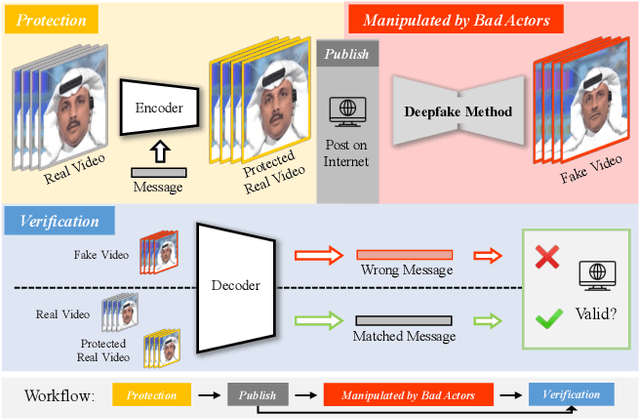



Abstract:The issue of detecting deepfakes has garnered significant attention in the research community, with the goal of identifying facial manipulations for abuse prevention. Although recent studies have focused on developing generalized models that can detect various types of deepfakes, their performance is not always be reliable and stable, which poses limitations in real-world applications. Instead of learning a forgery detector, in this paper, we propose a novel framework - Integrity Encryptor, aiming to protect portraits in a proactive strategy. Our methodology involves covertly encoding messages that are closely associated with key facial attributes into authentic images prior to their public release. Unlike authentic images, where the hidden messages can be extracted with precision, manipulating the facial attributes through deepfake techniques can disrupt the decoding process. Consequently, the modified facial attributes serve as a mean of detecting manipulated images through a comparison of the decoded messages. Our encryption approach is characterized by its brevity and efficiency, and the resulting method exhibits a good robustness against typical image processing traces, such as image degradation and noise. When compared to baselines that struggle to detect deepfakes in a black-box setting, our method utilizing conditional encryption showcases superior performance when presented with a range of different types of forgeries. In experiments conducted on our protected data, our approach outperforms existing state-of-the-art methods by a significant margin.
StyleSwap: Style-Based Generator Empowers Robust Face Swapping
Sep 27, 2022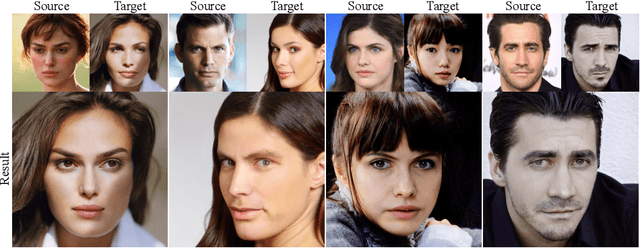

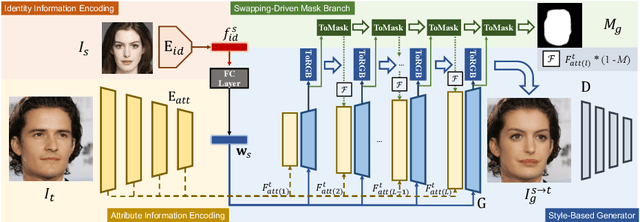

Abstract:Numerous attempts have been made to the task of person-agnostic face swapping given its wide applications. While existing methods mostly rely on tedious network and loss designs, they still struggle in the information balancing between the source and target faces, and tend to produce visible artifacts. In this work, we introduce a concise and effective framework named StyleSwap. Our core idea is to leverage a style-based generator to empower high-fidelity and robust face swapping, thus the generator's advantage can be adopted for optimizing identity similarity. We identify that with only minimal modifications, a StyleGAN2 architecture can successfully handle the desired information from both source and target. Additionally, inspired by the ToRGB layers, a Swapping-Driven Mask Branch is further devised to improve information blending. Furthermore, the advantage of StyleGAN inversion can be adopted. Particularly, a Swapping-Guided ID Inversion strategy is proposed to optimize identity similarity. Extensive experiments validate that our framework generates high-quality face swapping results that outperform state-of-the-art methods both qualitatively and quantitatively.
ForgeryNet -- Face Forgery Analysis Challenge 2021: Methods and Results
Dec 15, 2021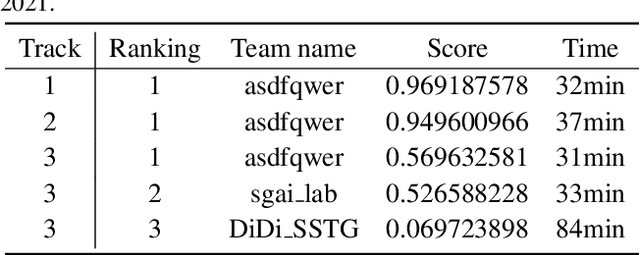
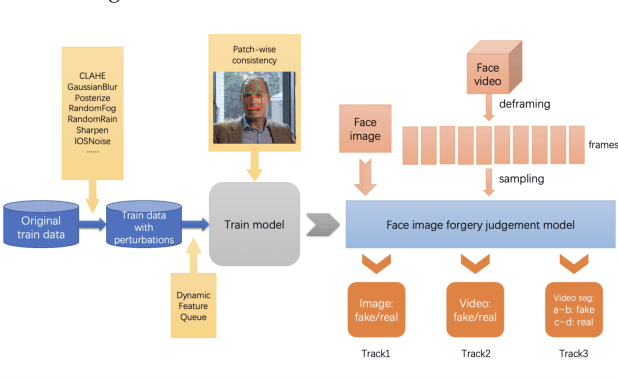
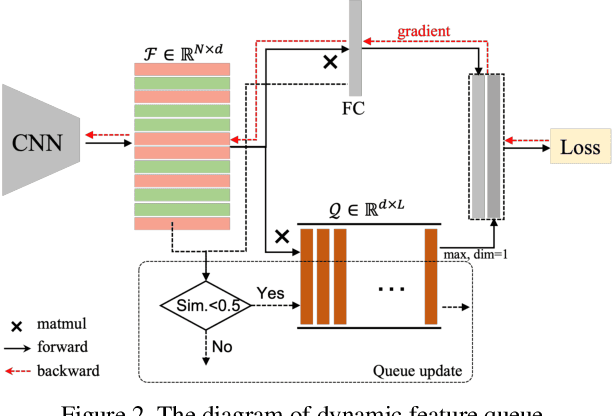
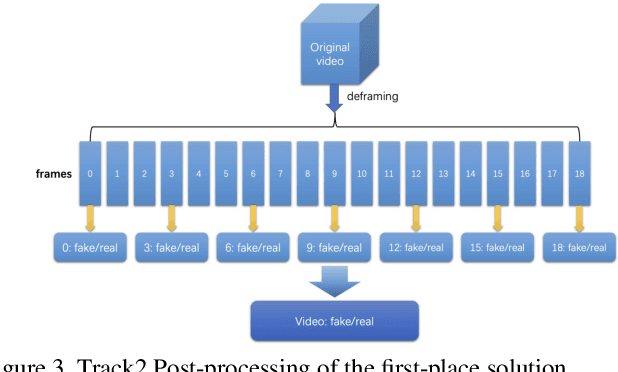
Abstract:The rapid progress of photorealistic synthesis techniques has reached a critical point where the boundary between real and manipulated images starts to blur. Recently, a mega-scale deep face forgery dataset, ForgeryNet which comprised of 2.9 million images and 221,247 videos has been released. It is by far the largest publicly available in terms of data-scale, manipulations (7 image-level approaches, 8 video-level approaches), perturbations (36 independent and more mixed perturbations), and annotations (6.3 million classification labels, 2.9 million manipulated area annotations, and 221,247 temporal forgery segment labels). This paper reports methods and results in the ForgeryNet - Face Forgery Analysis Challenge 2021, which employs the ForgeryNet benchmark. The model evaluation is conducted offline on the private test set. A total of 186 participants registered for the competition, and 11 teams made valid submissions. We will analyze the top-ranked solutions and present some discussion on future work directions.
 Add to Chrome
Add to Chrome Add to Firefox
Add to Firefox Add to Edge
Add to Edge